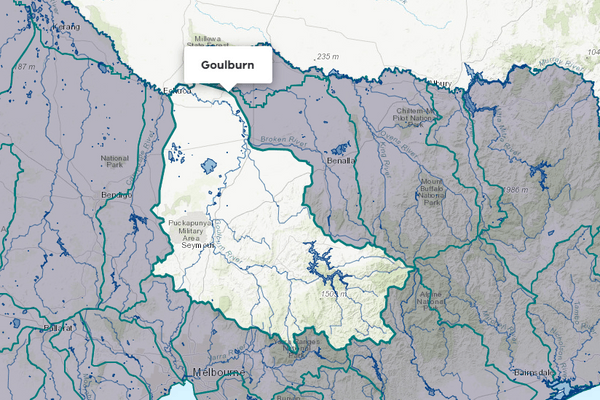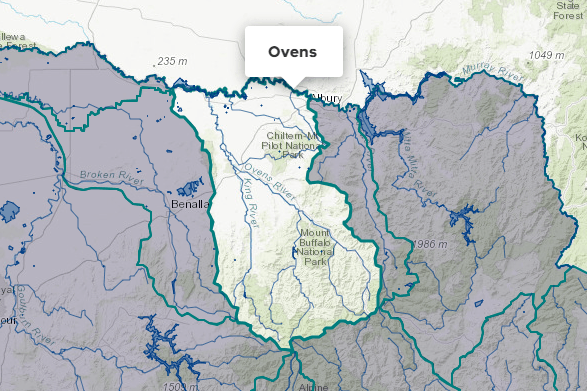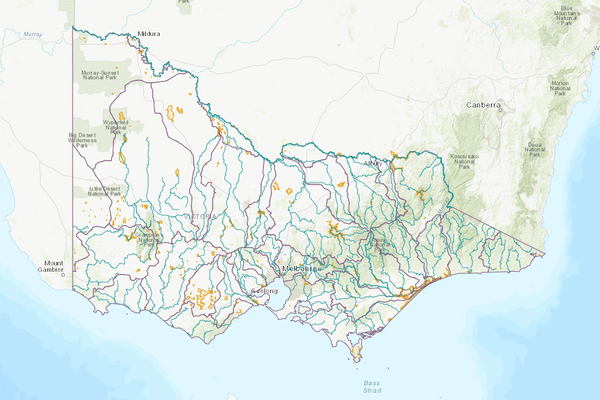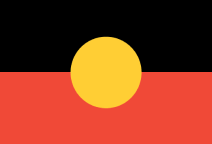About the area
The Broken basin is in northern Victoria. It contains 2 connected stream networks, that of the Broken River in the southern half and the Broken Creek in the north. The Broken River flows into the Goulburn River at Shepparton, whereas the Broken Creek flows into the Murray River at Barmah. For the purpose of these Accounts, the Lower Broken Creek is reported in the Murray basin.
Rainfall reliability across the basin varies, with the highest levels observed in elevated areas like the Tolmie Highlands, and the lowest on the plains.
Most of the basin has been cleared for agriculture which supports grazing in the south, and mixed cereal and livestock farming in the central region.
A significant portion of the northern sector of the basin falls within the Goulburn-Murray Irrigation District (GMID), supporting fruit cultivation, dairying, and livestock production through irrigation. For water accounting purposes, the Broken basin excludes the GMID, which is instead incorporated into the Murray and Goulburn basins.
More information on water management and accounting is detailed in Water explained.
2022-23 overview
Available water
Catchment inflow was higher than the previous year.
Licensed diversion restrictions
There was a similar level of restrictions on licensed diversions to the previous year.
Seasonal determinations
Entitlements received 100% high- and low-reliability allocations, the same as the previous year.
Water use
More water was diverted for consumptive and environmental purposes than the previous year.
When compared to the previous year, in 2022-23:
- more rainfall was received, catchment inflow was much higher, and storage levels reached a similar minimum
- there was a similar level of restrictions on licensed diversions from unregulated streams
- seasonal allocations were the same, with both high and low-reliability entitlements reaching 100% allocation
- more water was diverted from the basin for consumptive uses
- less water was diverted for environmental use.
Climate
2022 Flooding
In October 2022, a series of low-pressure systems or surface troughs travelled over south-east Australia, bringing heavy rainfall and storms. The cumulative impact of these on catchments and waterways led to widespread flooding in several basins. Major flooding in the Broken basin led to inundation at Orrville and Caseys Weir.
Rainfall
In 2022-23, rainfall across the entire Broken basin was very much above the long-term average. This was higher than the previous year, when rainfall was above average in all areas and very much above average in the central-east region of the basin.
Figure 1 displays the rainfall received in 2022-23 compared to the long-term average (1975-2023).
Figure 1: Rainfall deciles, Broken basin
Sourced from the Australian Bureau of Meteorology
River basin water balance
This section describes the known and estimated inflows, outflows and change of storage volumes in the basin.
Of the total inflows, 93% flowed out at the bottom of the basin in 2022-23.
Water balance table
The table below shows the total volumes of water available and supplied from water resources in the Broken basin in 2022-23.
Table 1: Water balance, Broken basin
Major on-stream storages
Major - greater than 1,000 ML - on-stream storages in the Broken basin are included in the water balance.
Storage levels
Storage levels were 101% in June 2023.
Same as the previous year
In June 2022 storage levels were 101% full.
Table 2: Storage levels, Broken basin
Inflows
Catchment inflow
Catchment inflow represents the volume of water flowing into the waterways of a basin. It is calculated as the total outflows and change in storage minus the known inflows.
Above average inflows of 732,078 ML were received (281% of the long-term average of 260,800 ML), over 3 times as much as the previous year (84% of the long-term average).
Above average inflow
Catchment inflow was 281% of the long-term average annual volume of 260,800 ML.
More water received than the previous year
Catchment inflow was over 3 times the volume of the previous year (84% of the long-term average).
Wastewater treatment plants
Water treated at wastewater treatment plants can be used to supplement water available in the basin. Water discharged to waterways from treatment plants is included as an inflow to the water balance.
Information on treatment plants is reported in the water supply local reports for the water corporation responsible for managing the plant.
In this basin, wastewater treatment plants are managed by North East Water.
Outflows
Diversions
In 2022-23, 14,109 ML of water was diverted from the waterway for town, domestic and stock, irrigation, commercial and environmental use, similar to the previous year (12,529 ML). While licensed diversions were similar to the previous year there was less water diverted for environmental uses and there was an increase of 3,340 ML in the estimation of small catchment dam use.
Small catchment dams
Water harvested, used and lost by small catchment dams (farm dams) is included in the water balance.
Table 3: Small catchment dams, Broken basin
Entitlements and compliance
Entitlements provide the basis for how water is shared in the basin.
Entitlements to water in the regulated part of the Broken basin provide for the right to carry over unused allocation to the next season. These entitlement holders can carry over unused water up to 50% of their high-reliability entitlement volume.
Consumptive diversions under bulk entitlements in the Broken basin are assessed against the Murray-Darling Basin annual cap target for the Goulburn-Broken-Loddon valley. Details of this assessment are published annually in the MDBA’s cap register and annual water take report.
Since 2019-20, the consumptive diversions are also assessed against the annual permitted takes under the Murray-Darling Basin Plan Sustainable Diversion Limit (SDL) compliance reporting which are annually published in the MDBA’s SDL accounts register of take and the Inspector-General of Water Compliance’s SDL compliance statement.
Entitlement volumes
Rights to water in the Broken basin are shown in Table 4.
Entitlement volumes represent a maximum volume of water that can be taken in a one-year period. The volume available in a particular year is dependent on the rules for allocating water set out in the entitlement and the seasonal conditions in that year, which can vary. The rules for allocating water under an entitlement differ between entitlements and systems. This affects the ability and likelihood of water being taken in a particular year.
Table 4: Annual entitlement volumes at 30 June, Broken basin
Available water and take under entitlements
Total water available under entitlements represents the volume of water that was available to be taken by entitlement holders in 2022-23. The volume includes carryover from the previous year, seasonal allocations and net trade into the basin.
Water available under entitlements
There was 34,508ML made available under entitlements in 2022-23. This was similar to the previous year (33,014 ML).
Water taken under entitlements
There was 12,255 ML taken under entitlements in 2022-23, more than the previous year (10,572 ML).
Seasonal allocations
- High-reliability entitlement allocations opened at 38% and reached 100% in September 2022 (the same month as the previous year).
- Low-reliability entitlement allocations reached 100% the following month in October 2022 (the same month as the previous year).
Restrictions on licensed diversions from unregulated rivers
- Diversions from Boosey Creek were banned for 9 months of the year, with the bans lifted from October-December 2022.
- All other streams were unrestricted for the year.
- Boosey Creek diversions were banned for the entirety of the previous year.
Available water and take table
This table shows the volume of available water and the volume taken under entitlements in 2022-23. Water taken under entitlements could be used for a variety of uses.
More information on available water and take has been detailed in How we account for surface
In 2022-23, a similar volume of water was available and more was taken under entitlements than the previous year.
Table 5: Available water and take under entitlements, Broken basin
Compliance
Compliance against water entitlements is reported for this basin in 3 areas:
- entitlement issued: that the volume of entitlements issued in a basin does not exceed formal caps, and has not increased without appropriate approvals
- water taken: that the volume of water taken during the year does not exceed the volume considered to be available for consumptive and/or in-stream use during that year
- bulk entitlement provisions: that holders of entitlements do not breach any provisions that are documented in their bulk entitlement orders.
Total entitlement volume
There was no net increase in the total entitlement volume from the previous year.
Total volume diverted
The total volume diverted under entitlements (12,255 ML) was within the volume available for the year (34,508 ML).
Individual bulk entitlements
No individual bulk entitlement holder took more than the annual volume made available to them.
Exceptions to compliance
Individual bulk entitlement holders complied with all provisions in their entitlements. However, a compliance difficulty was reported. See note below.
Note to compliance difficulties:
- Goulburn-Murray Water reported that there were 2 days when the flow at Back Creek Junction was less than 1.5 ML below the required daily flow, and one day when the flow at was 2.6 ML below the required daily flow, however the flows on all of these days were within the allowed tolerances.
Water for the environment
Environmental watering sites
Environmental watering sites and environmental values in the Broken basin that depend on water for the environment include:
- the Broken River, Upper Broken Creek and wetlands, which contain native fish habitat and a wetland of national significance
- Murray cod, trout cod and significant areas of intact riparian and floodplain vegetation.
Water from the Broken basin also flows into the Goulburn and Murray basins, helping to maintain internationally significant environmental assets in those basins.
Environmental water reserve
In 2022-23, water for the environment in the Broken basin comprised:
- water set aside for the environment through the operation of passing flows conditions:
- on consumptive bulk entitlements held by North East Water and Goulburn-Murray Water
- on licensed diversions
- 624 ML of high-reliability water shares and 23 ML of low-reliability water shares held for the environment
- all other water in the basin not allocated for consumptive uses: this water also provides social, recreational and cultural benefits.
Environmental water use
A total 1,146 ML of environmental diversion and 2,502 ML of environmental in-stream use was delivered in the Broken basin in 2022-23. The diversion was made up of deliveries to Upper Broken Creek. These deliveries are reported as off-stream diversions, as the amount is typically lost via evaporation and seepage along upper Broken Creek. There is no way to effectively measure throughflow to Lower Broken Creek.
Management responsibilities
Management of water in the Broken basin is undertaken by various parties
| Authority | Management responsibilities |
|---|---|
| Goulburn-Murray Water |
|
| North East Water |
|
| Goulburn Valley Water |
|
| Goulburn Broken Catchment Management Authority |
|
| Water supply system | 2021-22 (ML) | 2022-23 (ML) |
|---|---|---|
| Benalla | 1,490 | 1,549 |






